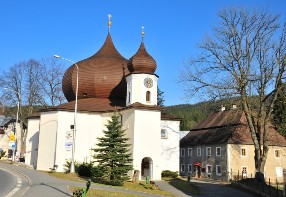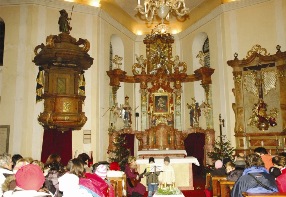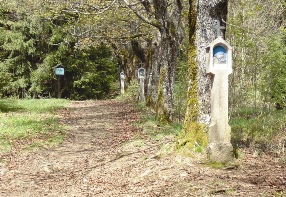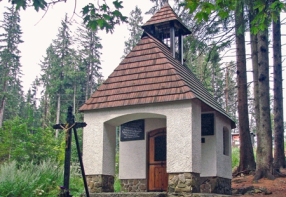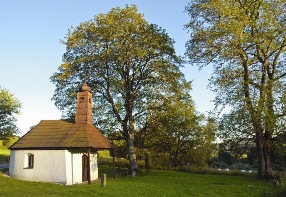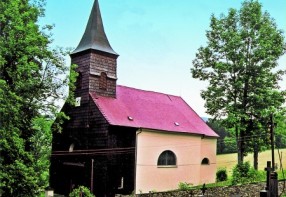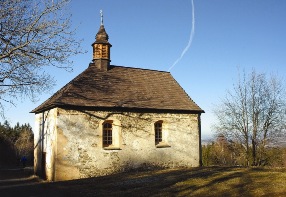RELIGIOUS MONUMENTS IN ŽELEZNÁ RUDA, HOJSOVA STRÁŽ AND SURROUNDINGS
Church of Our Lady Auxiliary of Hvězda in Železná Ruda
The church in the Baroque style was built from the order and at the expense of the Count Wolf Jindřich Nothaf of Wernberg in 1729-1732. Amongst it peculiarities we should name the ground plan in a shape of six-pointed star and two copulas with stars (instead of crosses, as is usual in catholic churches). It is consecrated to Our Lady Auxiliary of Hvězda.
The smaller tower with the main entrance was attached to the star-shaped church in 1770's. The whole roof is covered with shingles and its complicated truss was made by the local carpenter Matyáš Lehner. The interior furnishing was purchased by the glass-works owner Johan Georg Hafenbrädl. The visitors may admire a Marian altar painting, which is one of two copies of the painting of Madonna with Child by Lucas Cranach. The church has five side altars, a baptismal font made of the Šumava granite, a chandelier of the Šumava glass or epitaph tombstones of Kelheim marble with the carved coats of arms of Hafenbrädl family members moved in here from the cemetery, which was originally surrounding the church.
The eastern chapel serves as a chancel. In the western chapel there is the main entrance and a gallery with an organ above. The church roof was expensively reconstructed in 1995-1998 and the municipality also bought a new clockwork including the chime mechanism and a new bell. In the recent years, new plastering was provided and the dominant of Železná Ruda could fully excel after a long time again. Since the summer season of 2011 there are guided tours of the church organized several times a week.
Way of the Cross and Chapel of St. Anna
The surviving records of the Way of the Cross document its first consecration in 1815. The Way of the Cross was established from the initiative of the Železná Ruda vicar, J. W. Kobeck.
Until 1992 there were only granite posts standing along the Way of the Cross. They were damaged, with no paintings, there was no trace of a chapel at all. The reconstruction started upon initiation of Mrs. Milena Vobrová of Železná Ruda and Mrs. Helga Huttner-Hasenkopf of the Bavarian Zwiesel. It was financed from the funds collected mainly in Bavaria. The old photographs document that there used to be a chapel in the place. After uncovering of the foundations, the original undamaged tiling was found, which has been preserved for today's chapel.
The paintings at the Way of the Cross are copies of the originals by Johan Georg Wittmann. Together with the altar painting in the chapel they were painted in oils on aluminium sheet by the native of Železná Ruda, Mrs. Helga Huttner-Hasenkopf. She is also the author the windows of colour segments linked with lead in the chapel. The reconstructed Way of the Cross and the Chapel of St. Anna on Hladový hill in Železná Ruda were reconsecrated on 30th September 1995. Do not hesitate to come and relish beautiful atmosphere of the place.
Chapel of St. Anthony and St. Barbara, Cemetery of "Barabas"
The chapel called "of the Barabas" (term designates people working on building of railway tunnels) built in 1836-1839, originally as a part of the former Kopperle's farmstead, can be found beneath the railway station Železná Ruda - město. According to the traditional custom (especially from the neighbouring Bavaria), we can see bier placed beside the chapel. The family of Harwig Hauer (son of Franziska Kuchler who was a sister of the last chapel owner) still has in possession a linen spread taken from the chapel, decorated with beautiful embroidery and a sign "St. Anthony". After its reconstruction, the chapel was reconsecrated to St. Anthony and St. Barbara, the patron of miners, by the Bishop of České Budějovice, Antonín Liška, on 6th June 1999.
The chapel formerly also served for funerals of deceased persons and of the victims of an accident that took place in course of the construction of the Špičák tunnel. The church of Želzná Ruda used to be accessible only to Catholics and the same went for burials. The workers at the tunnel, who were mostly coming from the southern Europe, were usually of different religion. Nearby the chapel there is a large simple wooden cross indicating the place of the last rest of the deceased "Barabas". Many of the construction workers who came to the area to build the railway from their homes in Italy, Croatia or Dalmatia, were buried right here. For long years their remains were buried almost anonymously. The practically unknown heroes of the hard work were eventually buried with dignity in 2002, thanks to an initiative of the Železná Ruda Club.
Church of Immaculate Conception of Virgin Mary, Hojsova Stráž
The Church of Immaculate Conception of Virgin Mary, characteristic for its shingle roof, is the most significant historical monument of Hojsova Stráž. It was built in 1824-1826 in the place of a wooden Chapel of the Virgin Mary of the Rosary, which had been standing here since 1761. The altar of the church comes from the former chapel and was created by the Dešenice Master Jakub Brandt in 1762. The organ comes from the workshop of the Prague organ builder Josef Gartner and was installed in the church in April 1834 for 435 Austrian guilders. The subsidy granted by a governmental decree amounting at 420 Austrian guilders was insufficient and the municipality had to pay the rest of 200 guilders itself. Various concerts of the religious, classical and even popular music are held in the church during summer seasons and on Christmas.
Baroque Rectory, Hojsova Stráž
The Baroque rectory with shingle roof and covered doorstep from the 18th century is placed in close vicinity of the church. It has been standing in Hojsova Stráž since 1758 already, but it did not receive the authorization of establishment by the Court Bureau until 28th November 1785. The Episcopal Consistory nevertheless did not occupy the rectory again and the village therefore continued to belong into the authority of the parish of Zelená Lhota. The rectory fell in the official holding of Hojsova Stráž as late as in 1807.
Chapel of St. Cunigund on Prenet
The first written record of Prenet dates back to 1040, when it was mentioned in connection with the collection of so-called "Prenet duty". the Chapel of St. Cunigund was built here from the order of Bohuslav and Racek from Janovice, Lords of Riesemberk.
The Chapel of St. Cunigund on Prenet went through reconstruction in 1684-1687, when it received a new altar. During the World War I the bell from the chapel was requisitioned and in 1929 replaced with two new bells. After dislocation of the Germans in 1946 the village became completely depopulated. The chapel and farmyards started to slowly deteriorate. There is hardly anything left from most of the buildings and farms, and the chapel was expected to suffer the same fate. The civil association „Společnost Hojsova Stráž“ declares they want to renew and preserve this sight to be enjoyed by the next generations, too. However, the largely deteriorated baroque altar from 1687 with no decoration is the only thing left from the originally rich interior of the chapel. Another artefact from the chapel is the altar painting of St. Cunigund which is deposited in Zelená Lhota.

